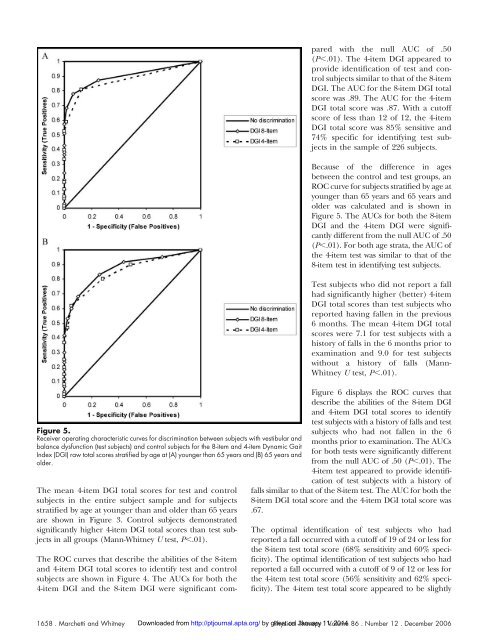Construction and Validation of the 4-Item Dynamic Gait Index
Construction and Validation of the 4-Item Dynamic Gait Index
Construction and Validation of the 4-Item Dynamic Gait Index
You also want an ePaper? Increase the reach of your titles
YUMPU automatically turns print PDFs into web optimized ePapers that Google loves.
Figure 5.<br />
Receiver operating characteristic curves for discrimination between subjects with vestibular <strong>and</strong><br />
balance dysfunction (test subjects) <strong>and</strong> control subjects for <strong>the</strong> 8-item <strong>and</strong> 4-item <strong>Dynamic</strong> <strong>Gait</strong><br />
<strong>Index</strong> (DGI) raw total scores stratified by age at (A) younger than 65 years <strong>and</strong> (B) 65 years <strong>and</strong><br />
older.<br />
The mean 4-item DGI total scores for test <strong>and</strong> control<br />
subjects in <strong>the</strong> entire subject sample <strong>and</strong> for subjects<br />
stratified by age at younger than <strong>and</strong> older than 65 years<br />
are shown in Figure 3. Control subjects demonstrated<br />
significantly higher 4-item DGI total scores than test subjects<br />
in all groups (Mann-Whitney U test, P.01).<br />
The ROC curves that describe <strong>the</strong> abilities <strong>of</strong> <strong>the</strong> 8-item<br />
<strong>and</strong> 4-item DGI total scores to identify test <strong>and</strong> control<br />
subjects are shown in Figure 4. The AUCs for both <strong>the</strong><br />
4-item DGI <strong>and</strong> <strong>the</strong> 8-item DGI were significant compared<br />
with <strong>the</strong> null AUC <strong>of</strong> .50<br />
(P.01). The 4-item DGI appeared to<br />
provide identification <strong>of</strong> test <strong>and</strong> control<br />
subjects similar to that <strong>of</strong> <strong>the</strong> 8-item<br />
DGI. The AUC for <strong>the</strong> 8-item DGI total<br />
score was .89. The AUC for <strong>the</strong> 4-item<br />
DGI total score was .87. With a cut<strong>of</strong>f<br />
score <strong>of</strong> less than 12 <strong>of</strong> 12, <strong>the</strong> 4-item<br />
DGI total score was 85% sensitive <strong>and</strong><br />
74% specific for identifying test subjects<br />
in <strong>the</strong> sample <strong>of</strong> 226 subjects.<br />
Because <strong>of</strong> <strong>the</strong> difference in ages<br />
between <strong>the</strong> control <strong>and</strong> test groups, an<br />
ROC curve for subjects stratified by age at<br />
younger than 65 years <strong>and</strong> 65 years <strong>and</strong><br />
older was calculated <strong>and</strong> is shown in<br />
Figure 5. The AUCs for both <strong>the</strong> 8-item<br />
DGI <strong>and</strong> <strong>the</strong> 4-item DGI were significantly<br />
different from <strong>the</strong> null AUC <strong>of</strong> .50<br />
(P.01). For both age strata, <strong>the</strong> AUC <strong>of</strong><br />
<strong>the</strong> 4-item test was similar to that <strong>of</strong> <strong>the</strong><br />
8-item test in identifying test subjects.<br />
Test subjects who did not report a fall<br />
had significantly higher (better) 4-item<br />
DGI total scores than test subjects who<br />
reported having fallen in <strong>the</strong> previous<br />
6 months. The mean 4-item DGI total<br />
scores were 7.1 for test subjects with a<br />
history <strong>of</strong> falls in <strong>the</strong> 6 months prior to<br />
examination <strong>and</strong> 9.0 for test subjects<br />
without a history <strong>of</strong> falls (Mann-<br />
Whitney U test, P.01).<br />
Figure 6 displays <strong>the</strong> ROC curves that<br />
describe <strong>the</strong> abilities <strong>of</strong> <strong>the</strong> 8-item DGI<br />
<strong>and</strong> 4-item DGI total scores to identify<br />
test subjects with a history <strong>of</strong> falls <strong>and</strong> test<br />
subjects who had not fallen in <strong>the</strong> 6<br />
months prior to examination. The AUCs<br />
for both tests were significantly different<br />
from <strong>the</strong> null AUC <strong>of</strong> .50 (P.01). The<br />
4-item test appeared to provide identification<br />
<strong>of</strong> test subjects with a history <strong>of</strong><br />
falls similar to that <strong>of</strong> <strong>the</strong> 8-item test. The AUC for both <strong>the</strong><br />
8-item DGI total score <strong>and</strong> <strong>the</strong> 4-item DGI total score was<br />
.67.<br />
The optimal identification <strong>of</strong> test subjects who had<br />
reported a fall occurred with a cut<strong>of</strong>f <strong>of</strong> 19 <strong>of</strong> 24 or less for<br />
<strong>the</strong> 8-item test total score (68% sensitivity <strong>and</strong> 60% specificity).<br />
The optimal identification <strong>of</strong> test subjects who had<br />
reported a fall occurred with a cut<strong>of</strong>f <strong>of</strong> 9 <strong>of</strong> 12 or less for<br />
<strong>the</strong> 4-item test total score (56% sensitivity <strong>and</strong> 62% specificity).<br />
The 4-item test total score appeared to be slightly<br />
1658 . Marchetti <strong>and</strong> Whitney Downloaded from http://ptjournal.apta.org/ by guest Physical on January Therapy 11, . Volume 2014 86 . Number 12 . December 2006
















